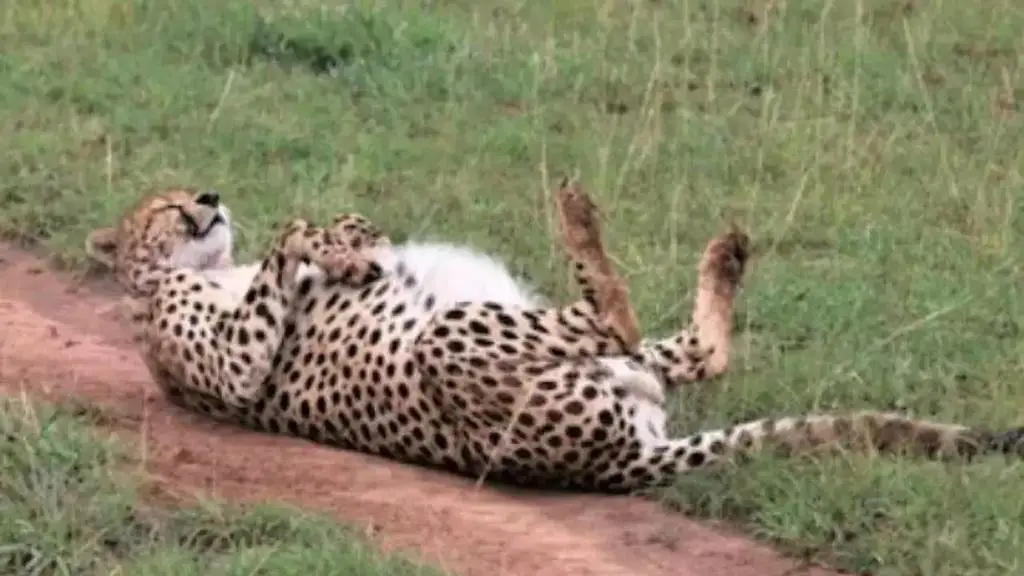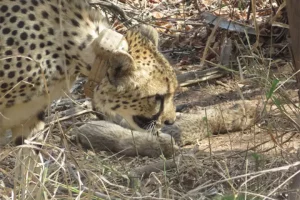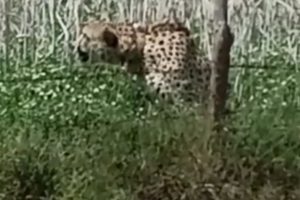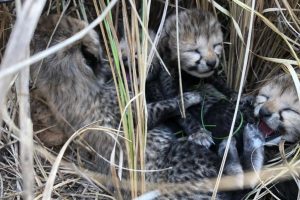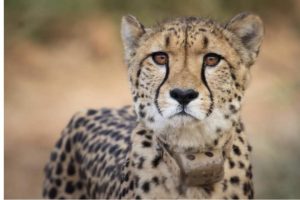By Digvijay Singh Khati
In 1952 cheetah was officially declared extinct in India. As per the official records the last three cheetahs were hunted by the Maharaja of Koriya (now a part of modern Chattishgarh) in 1947. The name of this cat, which along with the snow leopard is one of the big cats that can’t roar, is derived from the Sanskrit word chitraka which means spotted.
On September 17, 2022 eight African cheetahs from Namibia were released in Kuno National Park in Madhya Pradesh by Prime Minister Narendra Modi.
#Watch: Prime Minister Narendra Modi releases wild cheetahs that were brought from Namibia at Kuno National Park in Madhya Pradesh pic.twitter.com/JsrFKR4zaq
— INDIA NARRATIVE (@india_narrative) September 17, 2022
The reintroduction of cheetah species or may I say the ‘introduction’ of the African cheetahs in Kuno Palpur in Sheopur district of Madhya Pradesh has once again raised questions about the origin and existence of this feline species in the Indian subcontinent.
At #IndianOil, we are proud to power the #ReturnOfCheetah on Indian soil in collaboration with National Tiger Conservation Authority. As the #EnergyOfIndia‘, our environmental conscience aligns with our cherished core value of ‘Care’. pic.twitter.com/8HbwkfX8Ab
— Indian Oil Corp Ltd (@IndianOilcl) September 16, 2022
Now there are two schools of thought existing in the country regarding the origin of cheetah in the Indian subcontinent.
In his book The End of a Trail: The Cheetah in India, well known naturalist and hotelier Divyabhanusinh ji (representing the first school of thought) has given an extensive account of the origin and growth of this spotted feline in the Indian subcontinent.
Divyabhanusinh ji has strongly advocated that this animal was present in India much before the advent of the Mughal dynasty in our country.
On the other hand historian Romila Thapar along with the tiger expert Valmik Thapar and naturalist Yusuf Ansari in their book Exotic Aliens:The Lion and Cheetah in India have presented the argument that two species of big cats (lions and cheetahs) were introduced in the Indian jungles from Africa by the royal dynasties of medieval India for hunting purposes on Indian soil. They argue that these species were never a part of the Indian ecosystem before their artificial introduction into the Indian fauna by the royal dynasties.
Both schools are represented by eminent personalities that have contributed significantly in the conservation efforts of the environment in India.
So what is the truth?
Let us examine the data available to us regarding this species in India.
I would like to state that it has been (generally) observed by the authorities that in captivity cheetah does not breed. Vikram Nanjappa in his article Reintroducing Cheetah in India has stated an interesting incident from Mughal emperor Jahangir’s Iqbalnama “…it was found that the cheetah was very difficult to breed in captivity. When one pair did breed in captivity and produced three young it was precisely recorded by the Mughal Emperor Jahangir and by Mutamad Khan in his Iqbalnama. It was obviously a matter of joy to the Emperor since the event was so rare that is was considered it to be ‘among the curious events’ that occurred during the reign of Jahangir.”
So one can say that since the medieval times it has been observed that cheetahs do not breed in a stressful environment (for example in captive conditions).
Therefore the argument that the cheetahs (or their descendants) that were brought to India by the royalty in the medieval era went feral can be considered a weak one.
Now let us go to the scientific classification of this species.
Initially the cheetah family was divided into the following subspecies- the African cheetah (Acinonyx jubatus jubatus) was the first classification followed by trans Caspian cheetah (Acinonyx jubatus raddei), the Asiatic Cheetah (Acinonyx jubatus Venaticus) and the King Cheetah (Acinonyx jubatus).
Further scientific research led to a change in this classification. All the cheetahs in the region towards the south of Great Sahara in Africa were considered to be the subspecies Acinonyx jubatus jubatus. And the members of the cheetah family found to the north of the Great Sahara region and in the Asian continent were classified as Acinonyx jubatus venaticus.
The initial classification as well as the reclassification of this feline race indicates to a great extent that this cat was part of the natural order of the Indian subcontinent way before its said introduction by Indian royalty.
Now heading towards the current situation of this species across the area of its geographical distribution.
As per the latest findings there are fewer than 8,000 cheetahs left in the wild all over the world (source: National Geographic). The cheetah population is distributed in various African and Asian countries. Some of these countries are Namibia, South Africa, Botswana, Kenya, Tanzania and Iran. It should be noted that Iran has only 12 cheetahs left in the wild. The cheetah population that was found in India, Pakistan and Afghanistan went extinct around the 1950s.
Initially in India there were six big cats. These were the tiger, Asiatic lion, leopard, snow leopard, clouded leopard and the Asiatic cheetah. Since 1952 only the first five exist in India. The population of the remaining five big cats in India is considered healthy but faces the challenges of poaching and habitat loss. There is a need for stronger laws to control their poaching and opening of more corridors for dispersal of these species from their original location to other desired locations naturally.
Though it is the year 2022 which will be officially remembered as the year when the cheetah came back to India, the first attempt to achieve this reality was made in the 1970s. The Government of India had requested the Iranian government to share some of their wild specimens, so that they could be reintroduced in the Indian ecosystem. The Iranian cheetahs were the first choice for this reintroduction programme, as these specimens were genetically the same subspecies that existed in India before it went extinct.
The programme could not achieve success because even then the Iranian cheetah population was at a critical level, as a result the Iranian government could not provide the required specimens for the reintroduction programme of the Indian government.
The programme eventually saw the light of day when in 2017 the National Tiger Conservation Authority of India (NTCA) approached the Hon’ble Supreme Court of India for permission to reintroduce the African cheetah on experimental basis in Kuno Palpur in Sheopur district of Madhya Pradesh.
Finally in 2020 the Hon’ble Supreme Court of India gave the permission to reintroduce the African cheetah in India and constituted an expert committee headed by Dr. M K Ranjitsinh.
After consulting the cheetah experts in Africa this committee zeroed down on specimens from Namibia and South African for this programme. Of these specimens eight from Namibia were released in Kuno Palpur by Hon’ble prime minister of India, Shri Narendra Modi on September 17, 2022.
Second batch of these selected specimens will reach India on October 10, 2022 from South Africa.
If one hot topic of discussion is the origin of the Asiatic Cheetah then the other topic which gives this a tough competition are the apprehensions related to the reintroduction of these specimens in the Indian terrain.
Some experts, who have reservations regarding this programme, have argued that the area available in Kuno Palpur is not enough for the reintroduction of this species. They argue that the size of this location is not sufficient to accommodate the African specimens and that the size of grasslands in this area is not sufficient. Also the thick forest cover and hilly region in the surrounding area of reintroduction is going to be detrimental for the health of this species.
But I don’t agree that the size of this area is going to be an issue. Because when I visited Phinda Private Game Reserve in the 2000s, I saw the reintroduced cheetah population in that area of 170 sq km with small grasslands, woodlands and hills thriving. And Kuno National Park has an area of 748.76 sq km.
It is important to note that the above mentioned cheetah specimens were reintroduced in Phinda in the year 1992, and by 2013 these cheetahs and their descendants have already birthed 70 litters. A total of 124 cubs have been recorded in this area since then. And out of these specimens 53 have been successfully trans-located to other African locations.
From this Phinda population of reintroduced cheetahs, a total of three will be arriving in India along with the others in the second batch that arrives in October.
The other issue of these specimens being genetically different from the extinct Asiatic cheetah, that originally roamed in India, is another argument being raised by the same group of experts.
But naturalist Divyabhanusinh ji has counter-argued that there is a very minor difference in the genetic makeup of these two subspecies.
The third argument against the reintroduction of the cheetah in India is that there is a lack of prey base. Originally chinkara was the preferred prey for the Asiatic cheetah. But the population of this antelope in Kuno National Park is low and the spotted deer population is more dominant in this landscape.
But adaptation is the key in the survival of most apex predators. Taking the example of the Asiatic cheetah in Iran, which feeds on the wild sheep species Urial, one can safely conclude that the reintroduced specimens will successfully thrive on the spotted deer population along with the chinkara population and the four-horned antelope population as its prey base.
Some experts are pointing out that the striped hyena in this region can be a threat to the cheetah cubs born in the wild like the spotted hyena is in Africa to the cheetah cub population there. But once again experts like Divyabhanusinh ji have stated that unlike the spotted hyena that hunts in packs the striped hyena is a solitary predator. This predator behavior greatly reduces the risk posed by it to the cheetah cubs.
I would like to end this article by highlighting an interesting phenomenon/occurrence that happens when a species is introduced in a new location that has different wildlife than its native geographical location. During the initial days of my service in Dudhuwa National Park (Uttar Pradesh) when Asian rhinoceros was introduced from Assam and Nepal in this region, the camp elephants that were being used to monitor them ran away during their first interaction with this unknown species in their territory. Interestingly the rhinos had seen elephants in their original habitat, so they weren’t flustered by the presence of the camp elephants.
So a similar situation can arise when a native species will see these reintroduced specimens in Kuno National Park.
Now as the cheetah has already been successfully released in the wild in Kuno National Park, let us support the forest department of Madhya Pradesh and NTCA on the conservation journey of this big cat.
(Digvijay Singh Khati, former PCCF and Chief Wildlife Warden, Uttarakhand)
Also Read: PM Modi says it’s a historic moment for India as Cheetah is back after 7 decades






